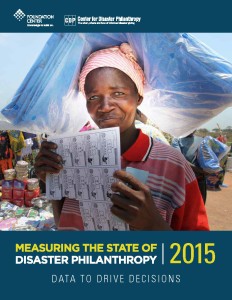The State of Disaster Philanthropy: More Risk-Taking, Please
The Center for Disaster Philanthropy and Foundation Center have recently issued their second annual assessment of disaster giving: Measuring the State of Disaster Philanthropy 2015: Data to Drive Decisions. The report provides an invaluable summary of giving data from 2013, the last year for which comprehensive information is available, and places U.S. foundation giving to […]

 The Center for Disaster Philanthropy and Foundation Center have recently issued their second annual assessment of disaster giving: Measuring the State of Disaster Philanthropy 2015: Data to Drive Decisions. The report provides an invaluable summary of giving data from 2013, the last year for which comprehensive information is available, and places U.S. foundation giving to emergency response in a global context by including information on government and private sector funding as well. In addition to the summary report, an interactive website allows for analysis and sorting of the data, an invaluable tool for philanthropy professionals and researchers.
The Center for Disaster Philanthropy and Foundation Center have recently issued their second annual assessment of disaster giving: Measuring the State of Disaster Philanthropy 2015: Data to Drive Decisions. The report provides an invaluable summary of giving data from 2013, the last year for which comprehensive information is available, and places U.S. foundation giving to emergency response in a global context by including information on government and private sector funding as well. In addition to the summary report, an interactive website allows for analysis and sorting of the data, an invaluable tool for philanthropy professionals and researchers.
Several aspects of the data struck me forcefully. First, the scale of U.S. disaster philanthropy is tiny by any measure: $116.9 million in donations compared to global disaster giving from all sources of at least $27.6 billion and, even more significantly, total U.S. foundation giving of $54.7 billion in 2013 as estimated by the Foundation Center. In other words, 0.2 percent of U.S. philanthropy goes towards mitigating, responding to, and recovering from disasters. In a world of ever-increasing incidence of natural disasters due to climate change and with forced displacement at levels not seen since World War II, that figure is shockingly low.
Second, when it comes to disaster philanthropy U.S. foundations tend to play it safe. Sixty-seven percent of their giving went to natural disasters; only 9.2 percent went to complex (i.e., conflict-driven) humanitarian emergencies. Fifty-four percent of giving was in North America. As for types of funding, 42.3 percent went towards immediate response, with only 12.8 percent going towards risk reduction and preparedness.
In short, this humanitarian relief professional finds the report sobering. Disaster philanthropy is a tiny percentage of overall giving, and what little is spent is largely spent on response in North America.
In the context of the substantial government giving in the humanitarian sector, perhaps the scale of U.S. philanthropy emergency giving is appropriate. But even within the limited parameters of available funding, foundations should be taking more risks. In 2015, 80 percent of UN funding appeals are for complex emergencies, dwarfing those for natural disasters. Clearly, more U.S. foundation funding should be directed towards complex emergencies.
The second area where greater risk taking is needed is in the risk reduction and prevention area. Especially given the tiny amount of available resources, investing in prevention offers the promise of far greater impact, whether in the U.S. or overseas. Yes, foundations would have to accept the risk of turning down immediate response projects in favor of ones that may not show results for several years. But if the robust U.S. foundation sector won’t take those risks, then who will?
